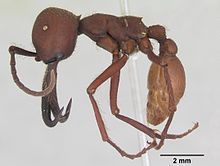
Ants are eusocial insects of the family Formicidae and, along with the related wasps and bees, belong to the order Hymenoptera. Ants evolved from wasp-like ancestors in the Cretaceous period, about 140 million years ago, and diversified after the rise of flowering plants. More than 12,500 of an estimated total of 22,000 species have been classified. They are easily identified by their elbowed antennae and the distinctive node-like structure that forms their slender waists.
Most ants are capable of biting, stinging, and spraying irritant chemicals. However, only relatively few species can harm humans; among which some can cause significant injury or, in rare cases, death. Like wasps, individual ants are capable of stinging multiple times as they do not lose their stingers.
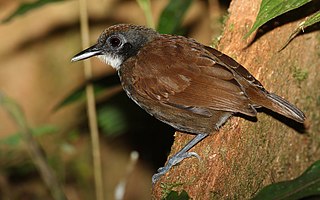
The antbirds are a large passerine bird family, Thamnophilidae, found across subtropical and tropical Central and South America, from Mexico to Argentina. There are more than 230 species, known variously as antshrikes, antwrens, antvireos, fire-eyes, bare-eyes and bushbirds. They are related to the antthrushes and antpittas, the tapaculos, the gnateaters and the ovenbirds. Despite some species' common names, this family is not closely related to the wrens, vireos or shrikes.

Dorylinae is an ant subfamily, with distributions in both the Old World and New World. In 2014, Brady et al. synonymized the previous dorylomorph subfamilies under the Dorylinae.

Carpenter ants are large ants indigenous to many forested parts of the world.

A bivouac is a structure formed by migratory driver ant and army ant colonies, such as the species Eciton burchellii. A nest is constructed out of the living ant workers' own bodies to protect the queen and larvae, and is later deconstructed as the ants move on.

Ant mimicry or myrmecomorphy is mimicry of ants by other organisms. Ants are abundant all over the world, and potential predators that rely on vision to identify their prey, such as birds and wasps, normally avoid them, because they are either unpalatable or aggressive. Spiders are the most common ant mimics. Additionally, some arthropods mimic ants to escape predation, while others mimic ants anatomically and behaviourally to hunt ants in aggressive mimicry.
Sphaeroseius ecitophilus is a South American species of mite.

Eciton burchellii is a species of New World army ant in the genus Eciton. This species, one of the most extensively studied ant species, consists of expansive, organized swarm raids that give it the informal name, Eciton army ant This species displays polymorphic caste features, with the soldier ants having much larger heads and mandibles. The colony lives in bivouacs, which are routinely moved as the foraging paths change. Eciton burchellii colonies cycle between stationary and more active nomadic phases. The colony raids are maintained by the use of pheromones, can be 200 metres (660 ft) long, and employ up to 200,000 ants. Colony members have been observed to fill "potholes" in the foraging trail, allowing for the faster and easier movement of captured prey back to the nest. Numerous antbirds parasitize the Eciton burchellii by using their raids as a source of food. In terms of geographical distribution, this species is found in the Amazon jungle and Central America.

Eciton hamatum is a species of army ant in the subfamily Dorylinae; it is found from Mexico to central Brazil and Bolivia. The species differs from Eciton burchellii, in that it does not fan out into the underbrush when foraging. Rather, it forages in columns, often in trees and preying exclusively on the larvae of other social insects. Its prey are often broods of vespid wasps and ants of genera Dolichoderus and Camponotus, suggesting that E. hamatum is mainly an arboreal forager.

Eciton is a New World army ant genus that contains the most familiar species of army ants. The most predominant and well-known species is Eciton burchellii, which is also more commonly known as the army ant and is considered the type species.
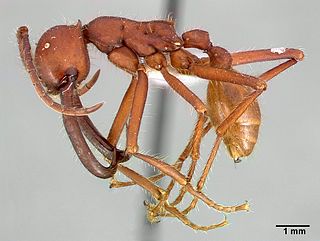
Eciton mexicanum is a species of New World army ant in the genus Eciton. Present from Mexico to throughout Costa Rica and northern Argentina, it is found in dry and wet forests in sea level to montane areas. Raids always occur in columns, tending to be usually nocturnal but are sometimes also encountered during the day. It is closely related to the Eciton burchellii species.

Myrmecophagy is a feeding behavior defined by the consumption of termites or ants, particularly as pertaining to those animal species whose diets are largely or exclusively composed of said insect types. Literally, myrmecophagy means "ant eating" rather than "termite eating". However, the two habits often overlap, as both of these eusocial insect types often live in large, densely populated nests requiring similar adaptations in the animal species that exploit them.
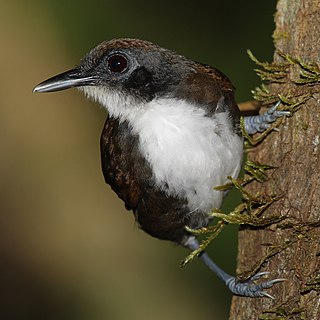
Ant followers are birds that feed by following swarms of army ants and take prey flushed by those ants. The best-known ant-followers are 18 species of antbird in the family Thamnophilidae, but other families of birds may follow ants including thrushes, chats, ant-tanagers, cuckoos, and woodcreepers.

Pheidologeton diversus, also known as Carebara diversa, is a species of marauder ant widely distributed throughout Asia.

Carl W. Rettenmeyer was an American biologist who specialised in army ants. He was born in Meriden, Connecticut and later attended Swarthmore College in Pennsylvania. He first became interested in army ants when he visited Panama as an undergraduate and then returned there as a postgraduate. Although he studied many aspects of army ant biology, he particularly focused on the animals associated with the ants and especially mites which live on the ants. He was well known for his photography of army ants, with his photographs appearing in over 100 publications and he used his video footage to create two DVDs. He taught at the University of Kansas from 1960 until 1971 and then at the University of Connecticut until his retirement in 1996, after being diagnosed with Waldenstrom’s macroglobulinemia. After his death in 2009, a set of papers on army ants were published in Insectes Sociaux in memory of his work.

Bombus transversalis is a bumblebee specifically native to the Amazon Basin. It is most notable for its surface level colonies which are built by the workers on the rainforest floor. Unlike its relatives, B. transversalis is able to thrive in a humid climate and fend off a wide range of predators because of its resilient nests. While there is great deal of information pertaining to their nests and foraging abilities, there is much more to be learned about relationships within the colony and life cycle of the bee.
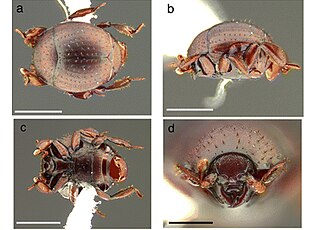
Nymphister kronaueri is a species of beetle native to Costa Rica, first discovered in 2014, The beetle has a habit of hitchhiking on army ants, and was described in 2017.
